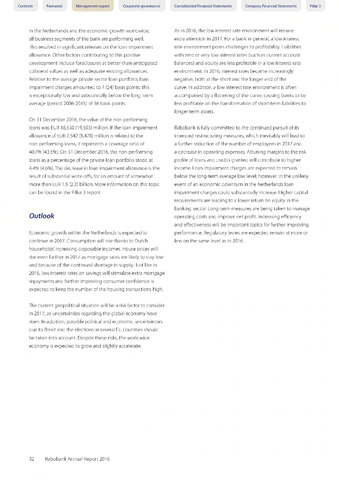Outlook
Contents Foreword Management report Corporate governance
in the Netherlands and the economic growth worldwide,
all business segments of the bank are performing well.
This resulted in significant releases on the loan impairment
allowance. Other factors contributing to this positive
development include foreclosures at better-than-anticipated
collateral values as well as adequate existing allowances.
Relative to the average private sector loan portfolio, loan
impairment charges amounted to 7 (24) basis points; this
is exceptionally low and substantially below the long-term
average (period 2006-2015) of 36 basis points.
On 31 December 2016, the value of the non-performing
loans was EUR 18,530 (19,503) million. If the loan impairment
allowance of EUR 7,542 (8,478) million is related to the
non-performing loans, it represents a coverage ratio of
40.7% (43.5%). On 31 December 2016, the non-performing
loans as a percentage of the private loan portfolio stood at
4.4% (4.6%). The decrease in loan impairment allowance is the
result of substantial write-offs, for an amount of somewhat
more than EUR 1.5 (2.3) billion. More information on this topic
can be found in the Pillar 3 report.
Economic growth within the Netherlands is expected to
continue in 2017. Consumption will rise thanks to Dutch
households' increasing disposable incomes. House prices will
rise even further in 2017 as mortgage rates are likely to stay low
and because of the continued shortage in supply. Just like in
2016, low interest rates on savings will stimulate extra mortgage
repayments and further improving consumer confidence is
expected to keep the number of the housing transactions high.
The current geopolitical situation will be a risk factor to consider
in 2017, as uncertainties regarding the global economy have
risen. In addition, possible political and economic uncertainties
due to Brexit and the elections in several EU countries should
be taken into account. Despite these risks, the worldwide
economy is expected to grow and slightly accelerate.
Consolidated Financial Statements Company Financial Statements Pillar 3
As in 2016, the low interest rate environment will require
extra attention in 2017. For a bank in general, a low interest
rate environment poses challenges to profitability. Liabilities
with zero or very low interest rates (such as current account
balances) and equity are less profitable in a low interest rate
environment. In 2016, interest rates became increasingly
negative, both at the short and the longer end of the
curve. In addition, a low interest rate environment is often
accompanied by a flattening of the curve, causing banks to be
less profitable on the transformation of short-term liabilities to
longer term assets.
Rabobank is fully committed to the continued pursuit of its
intended restructuring measures, which inevitably will lead to
a further reduction of the number of employees in 2017 and
a decrease in operating expenses. Attuning margins to the risk
profile of loans and credits granted will contribute to higher
income. Loan impairment charges are expected to remain
below the long-term average low level; however, in the unlikely
event of an economic downturn in the Netherlands loan
impairment charges could substantially increase. Higher capital
requirements are leading to a lower return on equity in the
banking sector. Long-term measures are being taken to manage
operating costs and improve net profit. Increasing efficiency
and effectiveness will be important topics for further improving
performance. Regulatory levies are expected remain at more or
less on the same level as in 2016.
32
Rabobank Annual Report 2016

